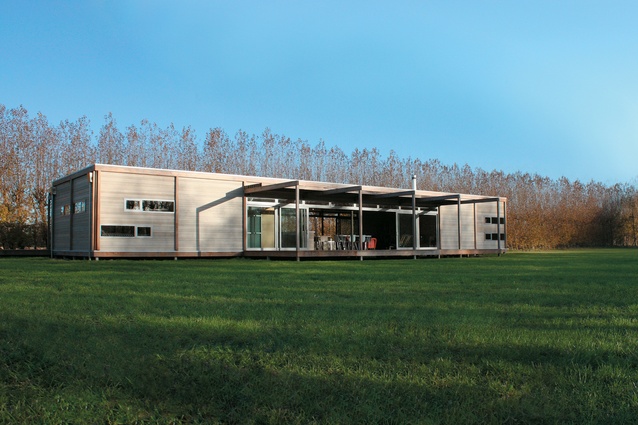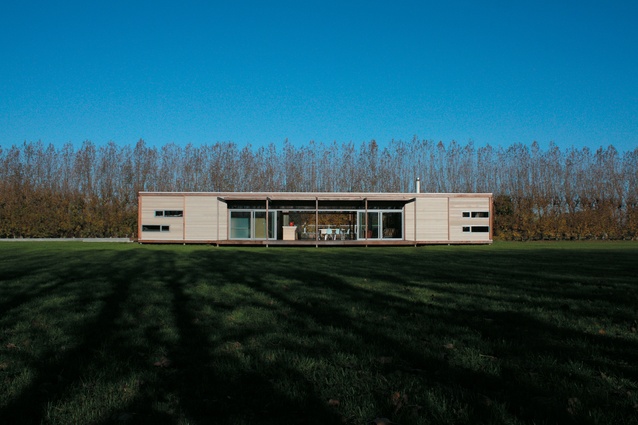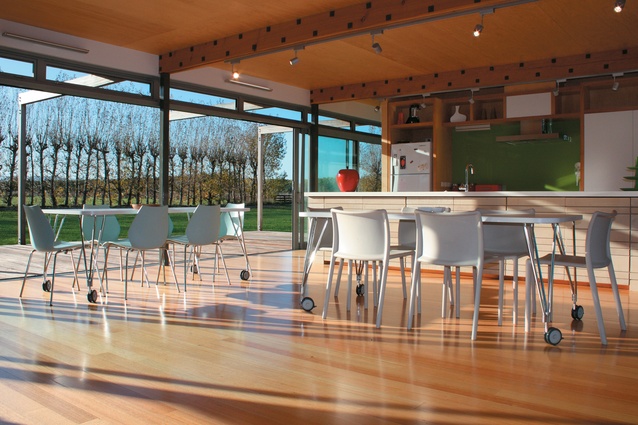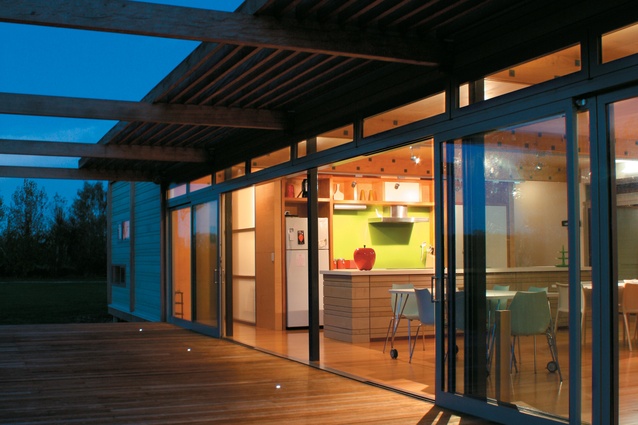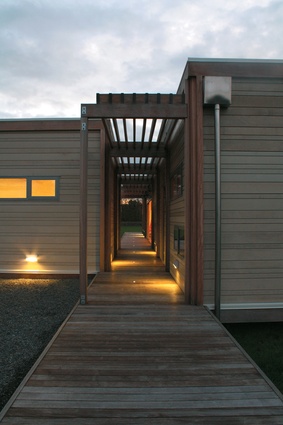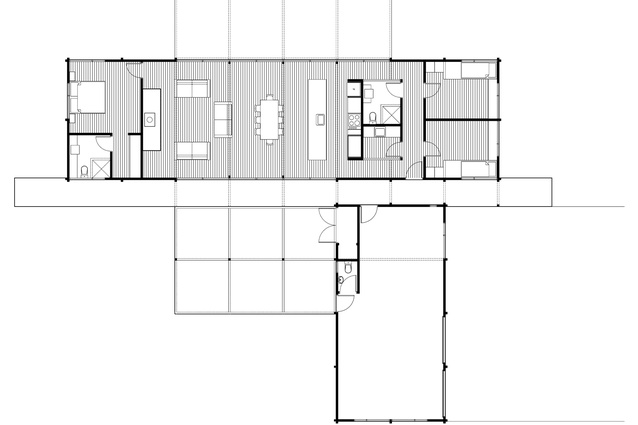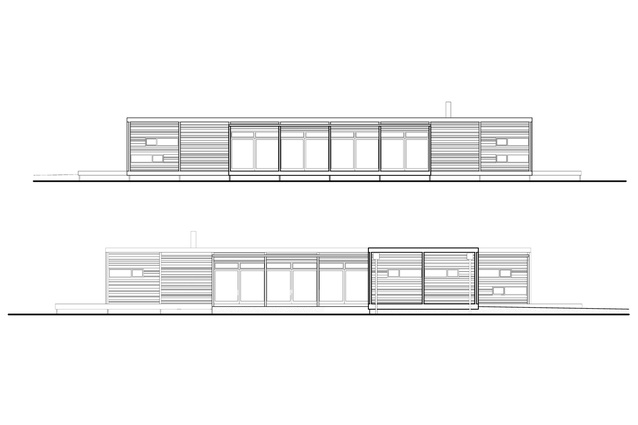Houses Revisited: Country crate
Richard Middleton takes design inspiration from a Wairarapa site’s former incarnation as an orchard.
Country living, and the generous proportions of a rural lifestyle block, rather than a bach at the beach, called to the owners of this weekend retreat on the outskirts of Greytown in the Wairarapa. With four boys aged between nine and 16, the space for onsite recreation and entertainment – swimming pool, tennis court and tennis table, pool table and potentially even a BMX track – offers family fun, peace, and a break from computer and TV.
It’s bucolic idyll tempered by pragmatism: after all, who would want country without plenty to keep the kids occupied – they won’t be happy putting their feet up or trailing around the wonderful wineries that have proliferated in Greytown, Gladstone and Martinborough. Wairarapa is bliss for townies – there’s the charm and peace of the countryside coupled with sophisticated amenities.
Indeed, the region is marketed as offering latté and lifestyle, wine and wilderness. It’s a blend that’s increasingly in demand – in the past decade viticulture and lifestylers are credited with helping reverse what had been a long decline in the region.
This house is located on a large block of land that was previously an apple orchard. It’s just little more than an hour over the windy Rimutaka Hill road from the family’s Wellington home. The family wanted to create something very simple and low maintenance that gave a sense of camping in the country.
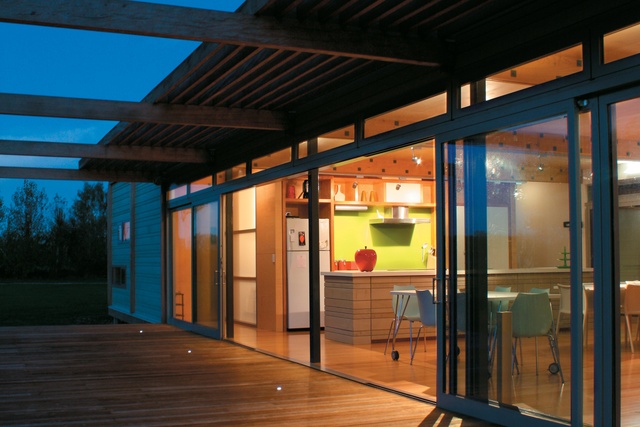
When they decided to use Novak+Middleton, who had helped renovate their city home, a desire for simplicity was the essence of the brief. They envisaged a house just one room wide but with separation between the adult and children’s spaces – kind of like the campsite where tents, offering private spaces of retreat, gather around a communal living area, says architect Richard Middleton.
When Middleton first saw the site, it was still covered in apple trees and the owners were planning to leave two rows intact on the northern boundary – unfortunately the contractor cleared the site right to the shelter belts on the boundary lines. However, although all the apple trees are gone, the memory of them is embodied in the building – the location and history of the site, along with the clients’ particular requirements, provided the creative concept for the house. Middleton says he very quickly conceived of the house as a series of stacked apple boxes with holes cut out where views in and out were required.
The house sits lightly on the site, almost appearing to float. Middleton explained that because the house is on a flood plain it had to be built off the ground. Interestingly, it was the rich alluvial soils of the flood plain that first attracted orchardists to the area in the early 20th century and led to Greytown becoming known as the fruit bowl of the Wairarapa.
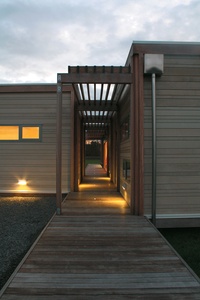
The building consists of two simple boxes sitting at right angles on the primary axis of the site and linked by an external boardwalk. The main entrance to the house is off this corridor and is deliberately understated and discrete, as Middleton – with both form and materials – wanted to avoid the conventions that speak to formal living and to create a more simple and casual ambience. However, at night, well-positioned lighting creates a welcoming path to draw visitors to the entrance.
The boxes have been positioned on the site to maximise the visual expanse of the property to the north, to allow maximum space for other activities and to use the eastern shelter belt to create a sense of enclosure. Planning is based on a regular and orderly module structure that loosely suggests the apple packing cases stacked ready for transport. A meandering driveway provides the only non-linear lines on the property, relieving the symmetry of the house and its site.
The exterior form references the internal functions of the house – the living area in the centre is transparent with floor-to-ceiling glass sliding doors, and the private spaces and bedrooms at either end are more solid and enclosed with slot windows cut into the mass to allow the inhabitants to have a view outside when lying in bed.
The transparency of the central pavilion form works well in the heat of a Wairarapa summer, which is often several degrees higher than Wellington, and while this is the modernist box it also conjures the Pacific fale with its open walls allowing any breezes to blow through and cool the interior. But, given this is not the tropical Pacific, double-glazing ensures warmth in winter.
In keeping with the apple box theme, the building materials are predominantly timber, although steel is used in the structure of the house, with flitch beams (where a steel plate is sandwiched between timber sheets and the three layers are bolted together) providing structural strength across the open living space and avoiding the need for internal columns.
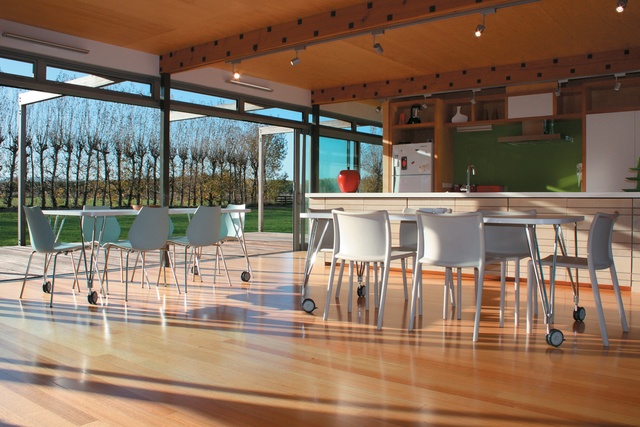
Steel beams extend out from the house over decks on both the north and south sides to create the sense of outdoor rooms. Most of the walls, both internally and externally, are timber – white-washed cedar with hardwood trim on the exterior and kitchen bench and plywood on most of the internal walls. Gib is used where colour contrast is required, with the colours used to match the apple theme.
This house has been designed to be flexible and to evolve with the family. Already the way it has been used is different to what was anticipated – the kids have abandoned their bedrooms in favour of the over-scale garage where they can hang out and play pool or table tennis, and sleep on day beds or communally on mattresses on the floor.
The house won a NZIA local architecture award for its “simple and elegant planning”. Richard Middleton has produced a design that is restrained and low key, a house that is easy-to-live in and suitably robust for a family of boys – and most importantly, the clients are delighted with it.
This article first appeared in Houses magazine


